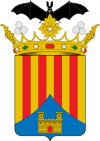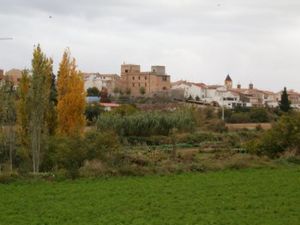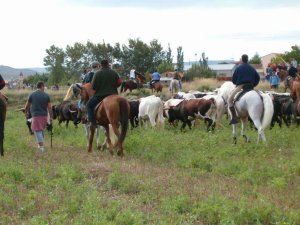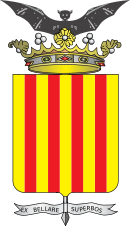Novallas facts for kids
Quick facts for kids
Novallas, Spain
|
|||
|---|---|---|---|
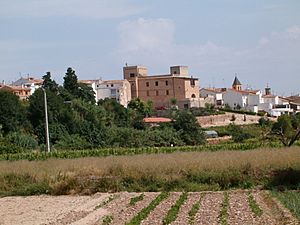 |
|||
|
|||
| Country | |||
| Autonomous community | |||
| Province | Zaragoza | ||
| Comarca | Tarazona y el Moncayo | ||
| Area | |||
| • Total | 11 km2 (4 sq mi) | ||
| Elevation | 425 m (1,394 ft) | ||
| Population
(2018)
|
|||
| • Total | 850 | ||
| • Density | 77/km2 (200/sq mi) | ||
| Time zone | UTC+1 (CET) | ||
| • Summer (DST) | UTC+2 (CEST) | ||
| Website | [1] | ||
Novallas is a small town in Spain. It is located in the province of Zaragoza. This province is part of the Aragon region. Novallas is also in a county called Tarazona y el Moncayo. In 2018, about 850 people lived there.
Contents
Exploring Novallas's Location
Novallas is found on the left side of the Queiles river. It is to the northwest of Zaragoza. The town is close to the region of Navarra. The land around Novallas is mostly flat. It slopes gently towards the west.
Distances to Nearby Cities
Novallas is about 100 kilometers from several important cities. These include Soria, Pamplona, Logroño, and Zaragoza. It is closer to Tudela, which is 15 kilometers away. The town of Tarazona is only 6 kilometers away. The large Moncayo mountain is 15 kilometers to the south.
How to Get There
You can reach Novallas by using the N-121 road. This road connects Tarazona and Tudela.
Local Weather
Novallas has a Continental Mediterranean climate. This means it has hot, dry summers and cold winters.
Novallas's Population Story
The number of people living in Novallas has changed a lot over time. For many years, the population went down. This started in the 1960s. But in recent years, the number of people has started to grow again.
Why the Population is Growing
This growth is happening for a few reasons. Many people have moved to Novallas from other countries. These include people from Romania and Ecuador. Also, houses in nearby towns like Tarazona are very expensive. Novallas offers lower housing prices. This makes it a good place for people to live.
Novallas's Economy
The main way people in Novallas used to make a living was through farming. However, farming is becoming less important now. Other activities like building, industry, and services are growing.
Farming in Novallas
Most of the farmland in Novallas is irrigated. This means water is supplied to the crops. The areas near the Queiles river have very intensive irrigation. The main crops grown are olives, almonds, and cereals. Many people grow fruits and vegetables for their own families. These include tomatoes, kale, borage, chicory, artichokes, and cardoon. In the past, growing grapes for wine was important. Asparagus was also a big crop. But now, there is not much wine or asparagus grown here.
Animal Farming
There are some farms that raise chickens. This activity has become less common recently. There are also some pig farms. Raising sheep is still important. Several groups of sheep are kept in the town. Long ago, most families had a few sheep and goats. They would gather them in a shared farmyard.
Local Crafts and Factories
Basket making was a traditional craft in Novallas. There were many workshops for it. But this activity has now stopped. The biggest factory in Novallas makes kitchen and bathroom furniture. Other businesses include carpentry, metal work, and vehicle repair. The town council has built a new industrial park. It is waiting for businesses to move in.
Working Outside Novallas
Many people from Novallas work in bigger towns nearby. They find jobs in factories and services. These towns include Tarazona, Tudela, and Zaragoza.
Building and Construction
Building houses and other structures has always been important in Novallas. There are now one or two companies that work in construction.
Novallas's Media
The town has a cultural magazine called "La Toque." It is the only regular publication in the village. Volunteers from Novallas write the magazine. The town council helps to support it.
Novallas's History
The area around Novallas has a long history. During the Roman times, people built farms here. These farms are still being studied today. Some of the main water ditches in the town were built by the Romans.
The Moors and Early Novallas
The Moors likely created the town we know as Novallas. They lived here until 1610. That was when the Moors were expelled from Aragon. The Moors built a great system of irrigation ditches. These ditches still supply water to the village's orchards. They also shaped the oldest parts of the town. It is thought that the church might have been a mosque first. The castle may have started as a Moorish fort.
Christian Conquest and New Name
In 1119, Alfonso I, known as The Battler, conquered Tarazona. It is believed Novallas was also taken around that time. A person named Fortún Aznárez was involved. The name Novallas probably comes from this time. It comes from the Latin word novalia. This means "new places" or "land ready to be farmed."
The Knights Templar
Years after the conquest, Lazarus, Fortún Aznárez's son, gave the castle to the Knights Templar. You can still see signs of the Templars in the church. There is a Templar cross carved on the outside. There is also a place between Novallas and Monteagudo called "Templars." People think a chapel used by them was located there.
Life with Christians and Moors
The Moors continued to live in Novallas. They were called Mudejar. They were the majority of the population. They had their own legal group called an "aljama." They also took part in town meetings. Christian families lived in the San Miguel neighborhood. There was a small chapel and a monastery there.
Wars and Changes
Novallas was located near the border of Navarre and Aragon. It might have belonged to Navarre for a while. This was after Alfonso I died and the kingdoms separated. During a war between Peter I of Castile and Peter IV of Aragon (1356-1369), Novallas was captured. It was later taken back by the Bishop of Tarazona's troops.
In 1610, the Moors were expelled from Aragon. This greatly affected Novallas. About 59 houses and 295 people, who were most of the population, had to leave. Novallas did not recover from this loss of people until the 1700s.
Town Symbols
Novallas's Culture
Traditions and Celebrations
Novallas has many interesting traditions:
- "La Vieja" (The Old Woman): This happens on a Thursday in the middle of Lent. Children ask their grandmothers for a snack. It is usually an omelet with Spanish sausage. They then go to eat it at a place called "Fuente Vieja" (Old Fountain). This spot is by the Queiles river.
- Santipol Pilgrimage: This is a special walk to a hill. A priest blesses the fields from a stone column there. The town council traditionally gives salty almonds and bread to everyone who takes part.
- San Blas Day: On the morning of San Blas day, people bless "roscones." These are special ring-shaped cakes.
- Novallas also celebrates San Antón and San Isidro.
Local Food
- "Rancho": This is a typical meal eaten by groups of people. It is a stew made with pork, hare, or rabbit and potatoes.
- During town festivals, a big lunch is held for everyone. The meal often includes white beans and bull meat.
- The local vegetables are very tasty. These include borage, chicory, artichokes, and cardoon.
See also
 In Spanish: Novallas para niños
In Spanish: Novallas para niños



